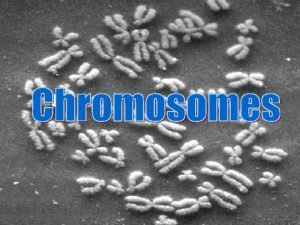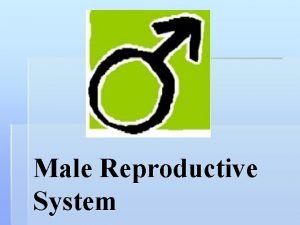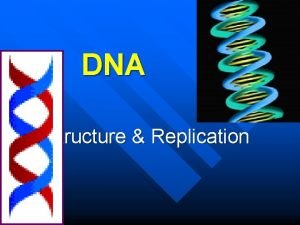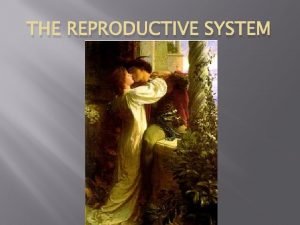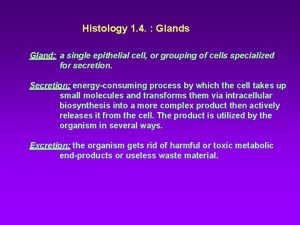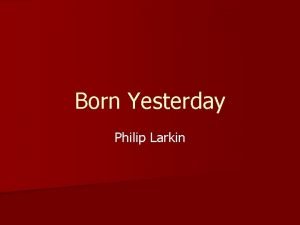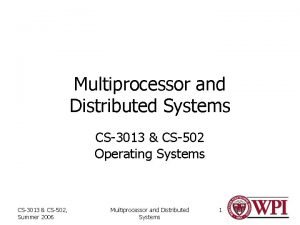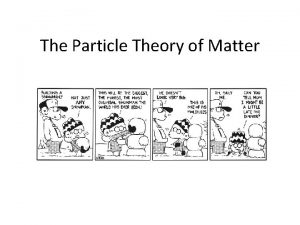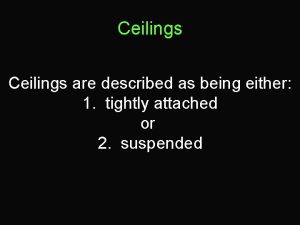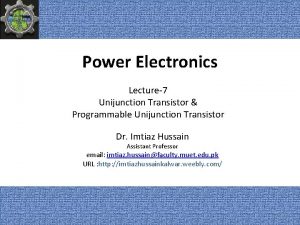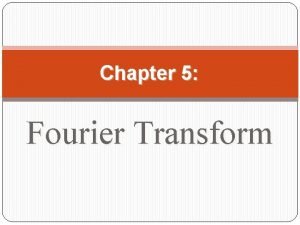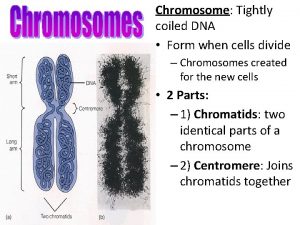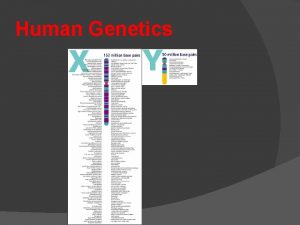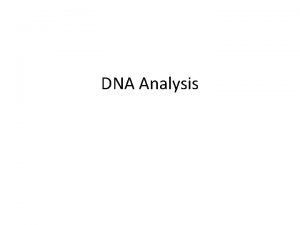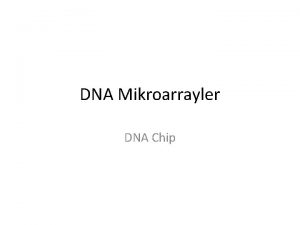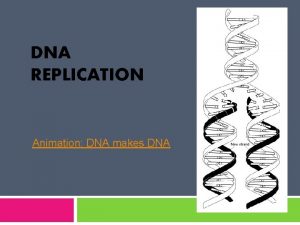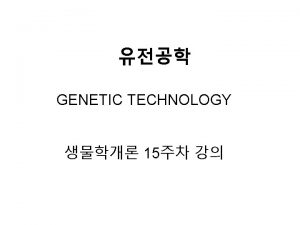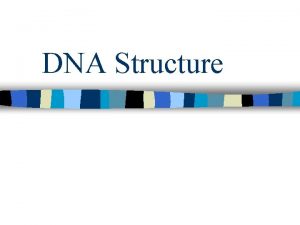Defined Tightly coiled DNA Defined Tightly coiled DNA

























- Slides: 25


• Defined: Tightly coiled DNA

• Defined: Tightly coiled DNA • Form when cells divide – Chromosomes created for the new cells

centromere left chromatid • Defined: Tightly coiled DNA • Form when cells divide – Chromosomes created for the new cells • 2 Parts: – 1) Chromatids: two identical parts of a chromosome – 2) Centromere: Joins chromatids right chromatid together

• Defined: Picture of individual chromosomes – Help identify sex & chromosome defects • Size of final pair identifies sex – Same size: XX = female – Different size: XY = male • Normal human will have 46 chromosomes per cell


It’s hard to know. that Once we I’m seeing something concerns examine me a littlethe bit. baby’s I thinkchromosomes we should weconsider will haveamore information. karyotype. Oh no! Is it serious?

Doctor: I’m gonna insert this needle and suck up some fluid. Cells from the baby should be in this fluid. Now that cells have been obtained, chromosomes can be seen and photographed

Under a microscope, the stained chromosomes are randomly scattered.

The lab technician arranges the chromosomes into pairs so the karyotype can be analyzed.

Down Syndrome: What’s Wrong? • Writing notation: – 1 st: total chromosome # – 2 nd: Sex chromosomes – 3 rd: extra or missing • Down Syndrome 47, XY, +21

Turner’s Syndrome: 30 seconds to discuss with your neighbor. • Write the notation for Turner’s Syndrome. 45, X, -23 or 45, X 0, -23

Patau’s Syndrome: 30 seconds to discuss with your neighbor. • Write the notation for Patau’s Syndrome. 47, XY, +13

Klinefelter’s Syndrome: 30 seconds to discuss with your neighbor. • Write the notation for Klinefelter’s Syndrome. 47, XXY, +23

• Diploid Cells: Cells with full set of chromosomes – Paired chromosomes – Humans: 23 pairs; 46 total • Somatic (non-sex) cells are diploid – Ex: Skin, Muscle, Nerve, Blood Cells • Created by mitosis

• Haploid Cells = Cells with ½ the total number of chromosomes • Gametes (sex cells) are the only haploid cells – Ex: Sperm, Egg, Pollen • Created by meiosis – Chromosome number reduced by half

I’m half mom How do humans get 46 chromosomes? and half dad. These 23 chromosomes are in the egg cell of mom. These 23 chromosomes are in the sperm cell of dad.


23 chromosomes 46 23 chromosomes Zygote (fertilized egg) is created

46 46 4646 46 46 Zygote 9 divides mitosis monthsby later…

Diploid Karyotype Haploid Karyotype Diploid karyotype: Chromosomes in pairs Haploid karyotype: Single chromosome

1 Minute: Discuss this rat karyotype with your neighbor. 1) Gender? female 2) Number of chromosomes in a somatic cell? 42 3) In a skin cell? 42 4) In a gamete? 21 5) In a diploid cell? 42 Notice there are 21 pairs of chromosomes 6) In a sperm cell? 21

1 Minute: Discuss this gorilla karyotype with your neighbor. 1) Number of chromosomes in a haploid cell? 24 2) gamete? 24 3) In a muscle cell? 48 In a zygote? 48 Notice there are 24 pairs of chromosomes 1) In an egg cell? 24

Quiz 1) What is the difference between chromatin, chromatids, 2) Name the location where chromatids connect. 3) Examine the karyotype. – What the haploid number? – Diploid number? – Somatic number? – Gamete number? 4) Which of the following cells are created by mitosis? Skin Nerve Sperm Brain Kidney Stomach 5) Which of the following cells are created by meiosis? Skin Nerve Sperm Brain Kidney Stomach 6) Which of the following cells are haploid? Skin Nerve Sperm Brain Kidney Stomach 7) Which of the following cells are diploid? Skin Nerve Sperm Brain Kidney Stomach and chromosomes? Pollen

8) Left, Middle, or Right: Which karyotype is from a diploid cell? 9) Left, Middle, or Right: Which karyotype could be from a muscle cell? 10) Left, Middle, or Right: Which two karyotypes could be from a sperm cell? 11) Left, Middle, or Right: Which karyotype is from an egg cell? 12) Left, Middle, or Right: Which two karyotypes are from a haploid cell?
 How to write chromosome notation
How to write chromosome notation Semen
Semen Coiled dna
Coiled dna Coiling basketry drawing
Coiling basketry drawing Space regainer types
Space regainer types The epididymis is a long coiled tube that sits atop the
The epididymis is a long coiled tube that sits atop the Coiled gland
Coiled gland A long narrow coiled tube where digestion is completed
A long narrow coiled tube where digestion is completed A collection of well-defined objects.
A collection of well-defined objects. Circles chapter 11
Circles chapter 11 Born yesterday poem summary
Born yesterday poem summary All resources are tightly coupled in computing paradigm of
All resources are tightly coupled in computing paradigm of Tightly coupled multiprocessor
Tightly coupled multiprocessor A bicycle chain fits tightly
A bicycle chain fits tightly A belt fits tightly around two pulleys
A belt fits tightly around two pulleys All resources are tightly coupled in computing paradigm of
All resources are tightly coupled in computing paradigm of Interstitial ceilings are useful where:
Interstitial ceilings are useful where: Particle theory of matter
Particle theory of matter Tightly attached ceiling
Tightly attached ceiling Dna and genes chapter 11
Dna and genes chapter 11 Bioflix activity dna replication lagging strand synthesis
Bioflix activity dna replication lagging strand synthesis Coding dna and non coding dna
Coding dna and non coding dna Enzyme involved in dna replication
Enzyme involved in dna replication Replication fork
Replication fork Application of unijunction transistor
Application of unijunction transistor Fourier transform definition
Fourier transform definition
